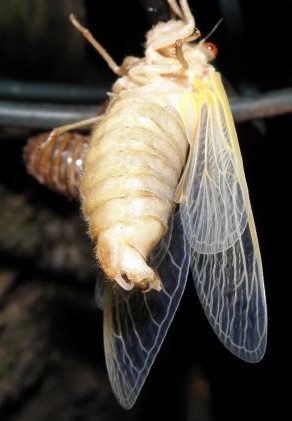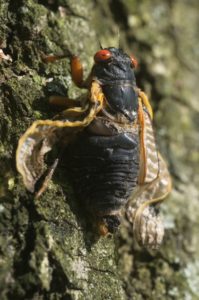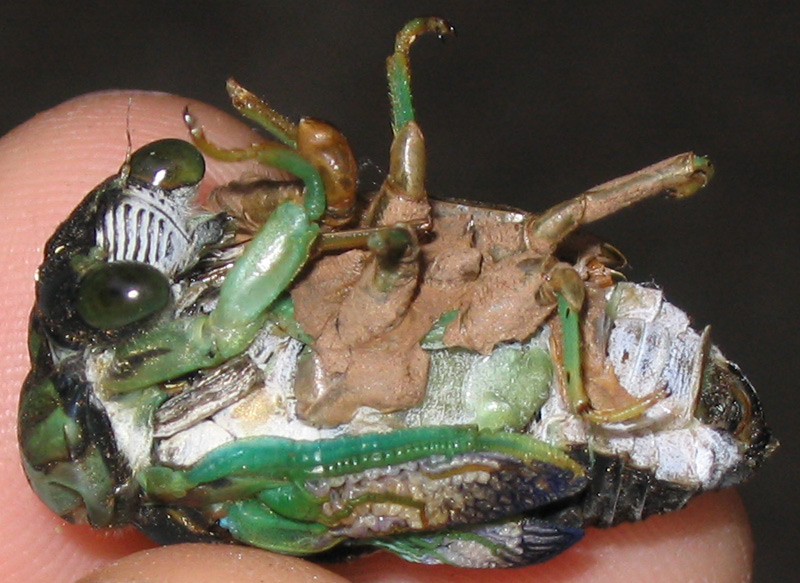You might notice that some cicadas have shriveled-up or otherwise damaged wings. Most of the time, wings become damaged during the molting process (ecdysis), specifically while their wings harden (sclerotize). Their wings and body are most vulnerable when they are still soft.

Some reasons why a cicadas’s wings might not get the chance to inflate and harden:
- If a cicada molts and its wings are not able to hang downward they won’t inflate with fluids and form properly.
- Cicadas often trample each other in the rush to find a place on a tree to molt.
- Harsh weather, like wind and rain, knock them to the ground or bend their wings when they’re soft.
- Pesticides
- Malnutrition.
- Physical weakness or defects.
- Fungi infection.
- Predator attacks.
Reasons 1 and 2 are due to humans reducing cicada habitat (forests & fields) and replacing the habitat with buildings, streets, sidewalks, etc. Yes — you are the problem :). But — you are also the solution. The best paper on this is “Faulty Eclosion in Crowded Suburban Periodical Cicadas: Populations Out of Control” by JoAnn White; Monte Lloyd; Jerrold H. Zar (https://www.jstor.org/stable/1937659?seq=1).

Just 10 Magicicada (American periodical cicadas) generations ago, the U.S. was mostly forest. Back then it was easy to find a vertical surface to molt on, or a plant stem to hang from. Today most forests have been replaced with agriculture, buildings, lawns, roads, sidewalks, parking lots, etcetera — so it has become increasingly difficult for periodical cicadas to find a good place to hang.
Magicicada can afford to lose a large number of their population due to wing malformations and other critical defects because there are simply so many of them — this loss falls in line with their predator satiation strategy.
However, if Magicicada cicadas lose too much habitat, they will go extinct (brood XI went extinct about 60 years ago). Lawns, roads, sidewalks, and other features of our human habitat create surfaces that are insalubrious for cicada molting.
Here’s a good photo by Jim Occi:

In the video below, you will see a cicada molting. Note that its wings are able to hang downward and inflate to form properly shaped wings. If the cicada tried to molt on a horizontal surface, the odds are its wings would be crumpled.
In the image below, there is a Neotibicen tibicen (not a periodical cicada) that sclerotized (hardened) before completely shedding its nymphal skin.

Although adorable, this Neotibicen will never sing or fly.
43 replies on “Why do some cicadas have shriveled up or damaged wings?”
Hello, I’m in Valparaiso Indiana. After reading the comments, I’m seeing the cicadas in similar areas of hatching, molting etc. many trying to hatch and only get a portion of its head neck out and die, many with deformed wings, many with the above photo half in and half out of its shell. Some actually look as if they have extra body parts and die mid hatch, some die fully molted and look perfect. Most of the deformed ones seem to have hatched correctly. They started hatching a week. I’ve tried to put many of them on the tree or closer to the trees from the yard, to prevent them getting stuck in the grass and cotton wood. But the deformities are coming from areas without grass as well. We’ve been here 21 years. Thank You
I am in the country in Franklin, TN. We have many cicadas on some of our trees, and I see quite a few with malformed wings and a number of dead or dying ones at the base of the tree. At first, I was really concerned, but now I’m wondering if I’m just seeing primarily the ones that can’t fly. There is quite a loud hum in the entire area, so I’m assuming the entire population is very large, and the visible ones just make it appear that the success rate is low. Thoughts? Also, are any of the malformations due to genetic anomalies?
Am I misunderstanding, or is this a typo? “If the cicada tried to molt on a vertical surface, the odds are its wings would be crumpled.” I though you were saying earlier in the article that they needed a vertical surface.
Also, I have hundreds in my yard. The majority of the ones by the oak tree are deformed, dead on the ground, have molting failure, etc. The one crawling up the tree look like raisins. But all of the ones about 20 feet away in the bushes look very healthy. Is this a fungus issue? I do not treat my lawn with pesticides. I’ve lived here since 1997.
Is your tree diseased or dying by any chance? I have many, many deformed cicadas in my backyard and I’m wondering if it is because my crabapple tree is on its “last legs” due to some disease. The tree has been slowly dying for years and is now dying at a faster rate.
I found one on the ground on it’s side, it’s wing was bent over and I have tried gently moving it’s wing back to it’s supposed to be, It sort of worked, It’s wing is still not normal. Its legs also seem to be messed up, I plan on keeping it as a pet so it can still live its life.
Excellent idea. I’ve kept injured ones as pets as well. Make sure it stays hydrated using a branch in water.
We found a cicada in the playground of the childcare I work at – the wings on this cicada seem to have each developed a blister of clear cyan fluid. Will this resolve without deficits to the cicada, or will it never fly?
Cicadas use that fluid to inflate and harden their wings. It is called Hemolymph and it is like their blood.
It may not be able to fly.
It should be able to climb branches and drink from branches, though.
If it is a male it still should be able to sing, and if it’s a female it should be able to flick its wings to respond to the songs of males.
Hi there. I found a little guy in laying on his back in some rocks near my house. his wing is flipped in the wrong direction and he cant fly. I made him a little terrarium with some sap because i read that they like sap but im not sure what to do with him. He flutters his wing often and he likes to hang ojt on the rim of the home i made him. What should I do with it?
Some people put them in an enclosure (tank, cage, etc) with an aloe vera plant. What I usually do is cut a short tree branch and put it in a vase and let them drink from that.
What type of tree do you use?
Usually maple or oak, but depends on the species.
If you’re in a pine forest, use pine.
I’ve found a cicada eaten alive by ants. I noticed it was moving and knocked off the ants off of it. I’m not sure it’ll live, but he’s hanging out with me. He appears to not have much strength and his wings are shriveled up. How can I give him a peaceful experience? I’m not sure he’ll make it.
I never saw that question before, but it is interesting. I hate to say it, but a quick “squash” would be the fastest end. Drowning in water would work. Freezing would take too long. Fire might take too long.
Hello, I came across your very helpful post after googling “cicada cannot fly”. I found a suspected female yesterday laying sideways in one of my hanging plants. I picked her up expecting her to try and fly away but she didn’t. I thought she had droplets of water on the end of her wings so I tried to wipe them off and she signaled almost like she was in pain. I’m assuming those droplets were irregularly placed fluid during the inflation process 🙁 I put her on my oak tree and she started crawling up it. She was beautiful, white and iridescent in color. Does she even have a chance of making it? I am in Tampa, FL.
@Kelsey,
The fluid is called hemolymph, which is similar to blood for insects. They also use it to inflate the veins of the wings. And when the wings are damaged, it leaks out.
There’s a chance it will survive. It’s body should harden, which will allow it to drink fluids from the tree.
i just found a single lone cicada today under my tree. stuck on his back trying to flutter his wings to get up. he was missing two legs and his wings were crumpled hard and deformed and black tipped. i looked everywhere possible for more. but i did find his shell right near him/her and looked in there and could see the two legs black and decaying inside the shell..a few bits of the wing areas he was missing. while i am curious on how it happened to him and why he’s up here alone on the hottest day of the year, im MOST interested in: SOMEONE PLEASE HELP ME SAVE HIM! lol i’ve been researching all day long and i don’t think he can use his mouth straw thing because he’s not moved it once. he still occasionally tries to flutter his wings and can’t use them. it’s heartbreaking. i took him so that a bird didn’t eat part of him and leave him to suffer that zombie cicada life. i’ve given him sticks and twigs and branches and he’s so sad and lonely and can’t sing of course. if anyone here can give me ANY tips
to help the poor thing let me know pretty pretty pleeeasse!!!! i either wanted his death to be quick and instant, or slow and in peace. just not from a predator ripping him apart. poor thing. my daughter and i have been crying for him all day long.
When their wings dry crumpled, I either keep them as a pet, or place them on a branch to see if they’ll crawl up the tree on their own power. If they’re strong enought, they might be able to manage just by crawling.
If you keep it as a pet, you can keep them refreshed with tree branches in a small vase of water.
How do I know if the wings are hardened? We found a cicada with crumpled up wings right next to his shell on the sidewalk while we were walking and I brought him inside so birds didn’t eat him. What should I do???
I have one more question about the fungus. Some of the Magicicadas I’m seeing (especially Septendecim) has what looks like white powder on their backs. Could that be a light dose of the fungus?
Do you have a photo (send it to cicadamania@gmail.com)
I’m really enjoying the cicadas so far (Cincinnati), but it’s early in their appearance so I may grow tired of them by the end. I’m amazed how many come crawling out of grassy areas at dusk, just in time to find a vertical spot before predators find them. I have on occasion helped them find a tree or an appropriate space for them to molt. I’m curious why so many continue to physically move despite not having a whole body. It saddens me that these little guys have waited 17 years and some won’t even get to molt properly, or will get eaten by birds and squirrels before finding a partner.
Once they emerge, they immediately struggle to find a vertical spot and begin to molt? How long after molting do they “mature” and begin to fly? And then how long until they start hoping for a mate? I notice as at dusk, they begin crawling up the sides of my garage, but by morning, most of them are gone, leaving their shells behind. I’m guessing as we sleep, they molt, “mature” and fly away? Seems so quick but they’ve been waiting 17 years so I guess it makes sense. My favorite thing is watching them molt. It’s really quite unbelievable. Nature at its best.
It usually takes more than a day before they can fly. They do molt at night and many of them climb up into the canopy of trees before you get to see them. There should be plenty closer to the ground for a few days as well.
I live in Oxford Ohio and am concerned to be seeing so many cicadas with deformed and damaged wings on the ground and on the side of trees.
Understand that the wings may be damaged moulting on the ground, but am seeing many on the sides of trees with stunted wings.
But there certainly are many healthy ones….
A load of cicadas I’m seeing in Washington, DC (~50%) have wing deformations. Many of them seriously deformed. I’m also seeing a number of them with black-ish tipped wings. Is that due to the fungus?
Nope. That is due to humans reducing their habitat or maybe pesticides. Why do some cicadas have shriveled up or damaged wings?
I’ve seen several cicadas that are missing the back half of their bodies. Does that result from a fungus?
That’s correct. It’s this: Which fungus attacks Magicicadas? Massospora cicadina.
They communicate it during mating.
Hi Amy, where do you live? I’m a reporter in Dayton, Ohio and I’m working with an entomologist who is working to find out where these Cicadas are. Thanks!
Hello Carly, I live in Cincinnati, Ohio and have noticed a lot of different deformities in the cicadas in my area this time around. Alot have fully developed wings and are not even able to fly, some are missing wings, parts and everything in between.
They can’t fly for a few days after molting
Hello,
I live in Berkeley Heights. It is located off Dorothy Lane just after Community Golf course. We have a large population of cicada.
New Jersey?! Fantastic!
Hi, I was planning to go with my husband to the New Brunswick/Princeton area this weekend. Do you know if the cicadas also emerge with the rain and wet days? If you have recommendations or contact where to find them, please feel free to contact me. Thank you.
There’s none in the New Brunswick area but Plenty in Princeton. You won’t hear them sing on cold/wet days, but there are thousands hanging from trees, weeds and other plants at places like the Princeton Battleground Memorial park.
I’ve noticed that some of the nymphs are emerging in the yellow, shriveled state (as tenerals), but others are emerging from their exoskeletons already in the fully hardened black form. Why is this? It’s like they’ve matured inside the exoskeleton before emerging. I imagine this might be one cause for the wing and other deformations but am trying to understand why this is happening in the first place.
Lori, I think the black ones you are seeing are not coming out of the exoskeleton they are standing on but previously molted from somewhere else. The issues described with vertical molting are not happening here, the nymph emerge hanging backward and downward (like doing a backflip off a diving board) and their wings inflate properly. We reach that nymphs (molting mostly at night – likely a predator strategy) are the most tender for eating, some likened them to shrimp. We collected a bunch, popped them in the freezer for about 5 minutes, then into a hot pan with a bit of EVOO and pepper flake. They take on the flavors of what they are cooked in and don’t really have a flavor or much texture of their own.
Thank you, John. Is there any way I can send you a picture of this strange molting process I think I’m seeing? About the problems with the wings, at least half of the adults I am seeing have deformed wings.
I’m seeing this also in our local park in Princeton, NJ. It seems like I see more cicadas with wing deformation and abnormal molting on Ash trees that have been injected with pesticides to kill the Emerald Ash Borer. Other molting sites in the park have considerably less deformed cicadas.
The ash trees have injection points at the base of the trunk where the roots begin. I’m curious if others are seeing this as well.
That could be it. A lot of pesticides do not discriminate. If you have any examples of elm trees with lots of shriveled cicadas, and it’s publically accessible, send me the location via email cicadamania@gmail.com. I will be discrete.
In the video description, it says;
‘In the video below, you will see a cicada moulting. Note that its wings are able to hang downward and inflate to form properly shaped wings. If the cicada tried to moult on a vertical surface, the odds are its wings would be crumpled’
Does that mean if the cicada emerges on a vertical surface, but nose down? Or should it be ‘If the cicada tried to moult on a horizontal surface’?
Depends on the species, but generally they molt on a vertical surface (side of tree), or hanging from one parallel to the ground. If the wings cannot hang, they’ll get crumpled. When cicadas try to molt on the ground, like a sidewalk, the wings cannot hang, so they get crumpled.
Good summary and ideas.